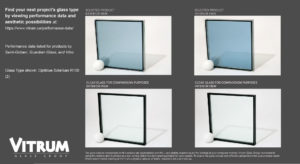5 Tips for Viewing Architectural Glass Samples
 When looking for glass types for an architectural project, start by comparing your project goals with the performance data for each glass type. This will greatly reduce the number of samples that you need to wade through. Vitrum Glass Group has compiled a comprehensive glass performance calculator at https://www.vitrum.ca/performance-data/ – this calculator will allow you to input your desired visible light transmission, % of exterior reflectance, u-value, solar heat gain coefficient and desired glass color. The glass types represented by our performance data are from the product lines of Saint-Gobain, Guardian Glass, and Vitro.
When looking for glass types for an architectural project, start by comparing your project goals with the performance data for each glass type. This will greatly reduce the number of samples that you need to wade through. Vitrum Glass Group has compiled a comprehensive glass performance calculator at https://www.vitrum.ca/performance-data/ – this calculator will allow you to input your desired visible light transmission, % of exterior reflectance, u-value, solar heat gain coefficient and desired glass color. The glass types represented by our performance data are from the product lines of Saint-Gobain, Guardian Glass, and Vitro.
Now that you`ve honed in on a few glass types that will enhance your project, it is time to view its real world application – in a sample size.
Architectural glass can be difficult to read when viewing standard size 12” x 12” samples. However, there are a few simple tips to help assist you the next time you are reviewing color glass samples:
- Always view glass samples outside under natural lighting conditions. It’s best to view samples outside at varying times of the day. If you had to choose one optimal condition, choose a slightly overcast day to determine the transmitted and reflected colours with the highest accuracy.
- To see the reflected color characteristics of the glass, it is recommended to look at the glass against a black background. If you can view a reflection or image from the glass surface, you have found the true reflected color of the glass. More importantly, these conditions will allow you to gain a good understanding of how the exterior of your glass / building will appear.
- Transmitted color is much less important, as you will not be able to perceive it once the glass is installed into the building, but if you are interested in learning all of the characteristics of your glass selections, view your sample on a white background.
- Looking at samples as close as possible seems to be an innate quality in all humans. However, the best way to actually view glass samples, is to view them from real life distances of 1m and 3m. This set back position provides a better perspective as more of the glasses’ reflective and color qualities will be visible.
- When you feel that you have perceived the color of the glass as close as possible to natural conditions and you understand and like the reflected and transmitted color of the glass, we recommend you order a full-size mock-up at the job site under various lighting conditions. This will allow you to see how the selected coatings affect reflectivity and transmission of color. Undoubtedly, seeing your selections come to fruition on a larger scale will also provide you with additional confidence and assurance as you move into the next phase of your project.
Perceived glass color can be influenced by a number of factors, some of which we try to mitigate here. However, remember that eventual lighting within the interior of the building, the reflectivity of the coatings selected, and the angle of observation will all play a role in determining the final appearance of your selections.
If you would like to order some glass samples or discuss the samples you have, please contact our architectural sale representative Mikhala Vail at mvail@vitrum.ca.